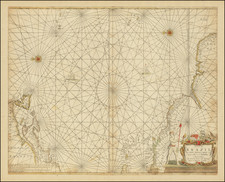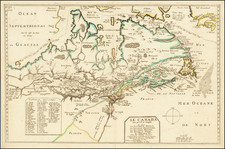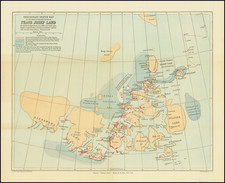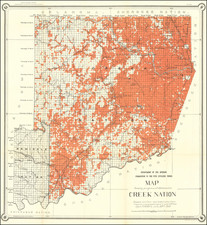Centered on the Great Lakes!
Nice example of Johannes Metellus's map of the north central regions of North America.
This is Metellus's copy of the map of Cornelis Wytfliet, issued in 1597. This was, at the end of the 16th Century, an enigmatic region virtually unknown to Europeans at the time of the map's creation. As noted by Burden:
The basic cartography is derived from Gerard Mercator's world map of 1569, which first depicted a large body of water inland in the extreme north. There has been speculation as to what this might refer to; it has been suggested that it could be a record of a voyage unknown to us that visited Hudson Bay , it could even be the remnants of the Verrazzano Sea theory. At the top of the map we find the Northwest Passage. . . Some sense of the extent of the map can be seen by the incorporation of the Septem civitates of the southwest, and Hochelaga, or Montreal in the east.
The map covers most of the central part of North America, from the American Southwest, Montana, Wyoming, Utah, Colorado, Alberta and parts to the north, to the Midwest, Great Lakes, and contiguous northern parts of Canada. The region shown at the bottom of the map is Nova Granada, and the map's coordinates place it more or less directly north of Metellus's Granata Nova et California, with the 7 Cities of Cibola (Septem civitates), the legendary Golden Cities of the American Southwest, showing at the bottom of the map, at what is probably the northern tip of the Rio Grande. The center of the map would therefore likely include the modern Midwest & Great Lakes region, with the region identified as Tolm Regnum is the eastern extension of the Tolm Regnum which appears on Wytfliet's map of the Northwest & Alaska ( Limnes Occidentis Quivira et Anian), which would place the Tolm Regnum in the general vicinity of Utah, Wyoming, Montana and contiguous parts of Canada.
While the region covered is virtually entirely myth and speculation, the map is probably best described as the first modern map to cover the Central parts of the United States and Canada, including the northeastern portions of the Transmississippi West.
Rarity
Unlike Wytfliet's map published a year earlier in 1597, the Metellus map is rare on the market. This is the first example we have offered for sale.
Johannes Matalius Metellus, also known as Jean Matal or Johannes Metellus Sequanas, was born in Poligny, Burgundy, France in ca. 1517. A humanist scholar, he was a polymath devoted to cartography, geography, law, paleography, and antiquarianism. Late in life he published a series of atlases; all his maps and atlases are rare and highly sought-after.
Matal was educated at Dole, Freiburg, and several Italian institutions. At Bologna, he met Antonio Agustín, a Spanish legal scholar, who recruited Matal to be his secretary. Together, the men researched ecclesiastical law, with an especial emphasis on Roman legal manuscripts, with trips to Venice, Florence, and elsewhere in Italy to study codices. In 1555, the two traveled to England to meet with Queen Mary on a mission for the Church.
After leaving his employment with Agustín, Matal traveled in the Low Countries and eventually settled in Cologne. There, he mixed with other savants, including especially Georg Cassander and Pedro Ximénez. It was in Cologne that Matal began his serious interest in mapmaking. He contributed to Braun and Hogenberg’s Civitae Orbis Terrarum; Georg Braun described him in glowing terms, “vir omni scientiarum genere praestans"—"a man outstanding in every form of knowledge."
Late in life, Matal began preparing a set of maps of the entire world. In 1594, he published an atlas of France, Austria, and Switzerland (39 maps), in 1595 an atlas of Spain (10 maps), and, posthumously, an atlas of Italy (37 maps), and one of Germany and the Netherlands (55 maps). Many of these maps were combined and augmented into atlases of Europe, Asia, Africa, the Americas, and the world’s islands. In 1602, a compendium work showcased all of these previous works called Speculum Orbis Terrae; this atlas was well received by contemporaries like Walter Raleigh and is very rare today. Many of these maps and atlases were released after his death in 1598, they were finished by his friend and fellow mapmaker Conrad Loew (Matthias Quad).









![[Unique Extra-Illustrated Example!] Carte Nouvelle Contenant La Partie d'Amerique La Plus Septentrionale, . . . Le Canada ou Nouvelle France, La Nouvelle Ecosse, La Nouvelle Angleterre, Les Nouveau Pais Bas, La Pensylvanie . . . Et Jle. de Terre Neuve . . .](https://storage.googleapis.com/raremaps/img/small/47720.jpg)



![Mexico [Texas on the Eve of Independence]](https://storage.googleapis.com/raremaps/img/small/84917.jpg)
